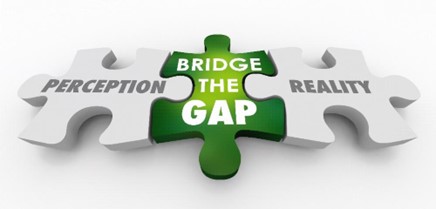 One of the more famous quotes by author John Moore is: “Your opinion is your opinion; your perception is your perception. Do not confuse them with ‘facts’ and ‘truths.’” It’s a good quote to keep in mind comparing perception versus reality when considering customer experience and CX of a company.
One of the more famous quotes by author John Moore is: “Your opinion is your opinion; your perception is your perception. Do not confuse them with ‘facts’ and ‘truths.’” It’s a good quote to keep in mind comparing perception versus reality when considering customer experience and CX of a company.
A recent study by Aquila, entitled Deliver the CX They Expect, revealed that 82% of 600 companies surveyed felt they were doing a good job. However only 10% of the 6,000 customers surveyed felt a company was meeting their expectations.
In the adapted words between the Apollo 13 crew and NASA, “Houston, we have a problem.”
The disconnect of corporate perception versus consumer reality is understandable. The rapid adoption of digital engagement is still maturing, and while companies may pride themselves on exceptional service, that’s not the same as an exceptional customer experience leading to a CX gap between an organization and their customers.
What’s the difference? Customer service is a component of customer experience where customers engage in human interaction for support.
Customer experience is the sum of the entire customer journey with a business and all its touchpoints.
The Tenets of Expectation in Customer Experience
There are ample studies about customer experience expectations. In virtually all cases, these studies identify three key tenets of what customers are looking for in their journey with a company:
- Seamless/Connected Cross-Channel Experience: Nearly three-quarters of customers surveyed by Salesforce report, State of The Connected Customer stated they use multiple channels to start and complete a transaction.
- Personalization: It’s not about using their name three or more times in a conversation; it’s about personalization of their experience based on intent and history—Know me, Know where I’ve been and Know what I need to do next.
- Convenience and Respect for Time: Time has become their most valuable asset, which strengthens the importance of offering fast, simple and convenient interactions.
The ability to identify the CX gaps in your perception of customer experience and your customers’ reality is a matter of plotting a course.
A Customer POV in mapping CX
The first step in mapping the customer journey begins with understanding the problem the customer is looking to solve. The journey must begin from the customer’s point of view, not the corporate perspective. What is their motivation or trigger to reach out to you?
For instance, as you map out the journey across multiple interaction points, the integration of natural language processing can be helpful. Identifying sentiments and common questions in chatbots can begin to identify bottlenecks and friction.
Mapping the CX journey requires collaboration among multiple operating areas. Be sure to evaluate channel silos in operating areas as well as back-end process flows with no bias. This is about the Customer’s journey!
Further, evaluation of call reasons, call transfers, repeat contacts, website opt outs, back-office bottlenecks can all provide insights into where automation can be introduced, where marketing can be enhanced, where contact center education can be delivered to better set the back office up for success, etc.
Customer Journey Mapping helps in building a clear understanding to rectify CX Gaps in your organization
The collaborative approach to a quality customer experience is critical to building the seamless experience for the customer. This can seem like a huge task—and it can be but remember everything doesn’t have to be done right now.
Start small, with your contact center.
For example, What do your voice-of-the-customer surveys and customer complaints tell you are barriers to satisfaction? Now look at data and see how often these aggravators are occurring. Which call reasons happen most often? Is there a self-service opportunity? If one exists, is it easy to find or interact with?
Try the journey for yourself from the customer’s point of view and begin a journey map.
Another piece of advice for you to remember – The 5 Whys. The 5 Whys is the iterative questioning technique to get to the root cause of a problem first developed in the 1930s by Sakichi Toyoda, the Japanese industrialist, inventor and founder of Toyota Industries.
A foundational element of the 5 Whys is not to take the first answer at face value.
Ask why, then repeat that question until you feel you have gotten to the true reason for the aggravation to occur—and the reality of your customer experience. When it comes to customer experience, your perception versus the customer’s reality can mean the difference between viability of your brand and vulnerability.
You have to gain insights into the customer sentiment through AI, social media, customer comments and surveys.
Don’t forget the importance of a consolidated view of the customer across all channels, which requires data analytics and insights. Consolidation of data helps in reducing gaps in your CX.
Finally, leverage data for trends that relate to a negative experience for your customers and then begin a journey mapping process. Now when you ask How am I doing with my customer experience?— the answers may be much more satisfactory!
DecisivEdge can help your organization close gaps in your CX Transformation.

